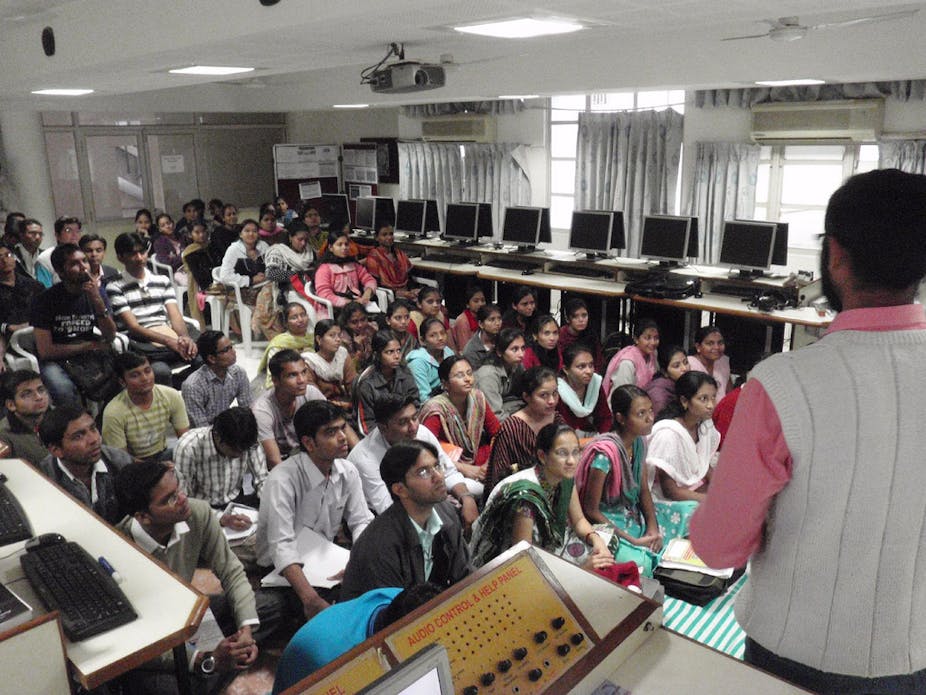The numbers are numbing. India is home to 1.2 billion people (a seventh of the world’s population), of which 230 million are school students and 23 million are studying at higher education institutions - including around 500 universities. Although one million Indians study overseas, another 5 million want to join them.
The scale of the education opportunities alone is enough to justify Ted Baillieu’s Super Trade Mission to India. On the tour are 250 delegates from 200 businesses and institutions spanning a range of industries - automotive, aviation and aerospace, clean technology, food and beverages, information and communications technology, life sciences, sustainable urban design, tourism and, of course, education.
The biggest delegation is from the higher education sector, including vice-chancellors from the universities of Deakin, Latrobe, Melbourne, RMIT, Swinburne and Victoria, as well as senior representatives from Monash, Ballarat and 14 TAFE institutes.
Premier Baillieu told the Indian delegates that Melbourne has been voted the fourth best city in which to study worldwide. It is home to students from 165 countries, and is the preferred destination for 40% of all Indian students in Australia.
He said Melbourne aims to strengthen that position: “Education is the glue for long-lasting relationships, friendships and partnerships. And the sharing of knowledge is the basis for social and economic progress.”
Minister Louise Asher, whose Department for Business and Innovation put together the Trade Mission, said “university partnerships would be the basis of building mutual respect and improving relations between India and Australia”.
The minister is keen for Victoria’s TAFE sector to be more involved in delivering skills training for India.
In turn, the Indian higher education sector is eager to do deals with foreign education providers to build the “capacity” they need to train students at home. As Professor Rajeev Shorey, the Vice-Chancellor of NIIT University, said: “If you don’t partner in the modern world, you perish.”
A centrepiece of the Delhi meetings was an Education Roundtable discussion between the Victorian delegation and 17 Indian vice-chancellors, plus representatives from all the major education bodies in India.
The Indian representatives briefed the Victorian delegation on a range of matters. They told us that India gained territorial independence in 1947 but only gained economic independence in the 1990s, when the country was deregulated and opened up for business. It is now making education a priority because its “demographic nightmare is that we can’t educate and skill the nation”, and that, as a result, India could be left behind, particularly by China. At present 12.8 million people enter the work force every year!
They stressed that India needs to build more schools, colleges and universities if it is to realise its goal - to make 500 million Indians skilled by 2022. Currently there are just 2.5 million university places.
To this end, India is forging partnerships with foreign universities and skills providers. It is also relying heavily on domestic public-private partnerships, but there remains a mistrust of private providers who put profit ahead of public outcomes.
Australian vice-chancellors are keen to get involved, but complain that excessive red tape and complex regulations hinder partnership agreements. If this can be addressed, Australian universities believe they can help. They worry, however, that even while capacity is being built, the quality of many of the courses will be dismal - leaving graduates unemployable.
The Indian government told Premier Baillieu that although it supported wider engagement with Victorian universities, it wanted an assurance that Indian students would:
- be provided with good hostel accommodation
- receive the same transport privileges enjoyed by domestic students
- be taught only by accredited providers
Professor Dinesh Singh, the Vice-Chancellor of Delhi university, which has 200,000 students, sounded a note of warning: the sheer size of India’s growing middle class meant that the education problem could not be solved by building more universities alone. Professor Singh urged the delegation to consider new ways that students could engage with information through digital platforms, and called for the creation of a new “Meta University knowledge network”.
Forging a stronger partnership
During the Delhi meetings, La Trobe University signed a Memorandum of Understanding with HCL Technologies, and another with the Birla Institute of Technology; Deakin signed a Memorandum of Understanding with the Indian Institute of Management; Melbourne with the University of Delhi; Swinburne with AutoCRC Jaypee University of Information Technology; Victoria University with Ganpat University.
Premier Ted Baillieu awarded 10 Victoria India Doctoral Scholarships to Indian PhD students to study at Victoria’s universities. Each scholarship is worth $90,000 over three years and the only criterion, aside from research excellence, was that the projects be of benefit to both Victoria and India.
Premier Baillieu said: “Victoria is the leading education provider in Australia and international education is Victoria’s largest export sector, worth $4.8 billion to the economy.”
After the announcements the Indian media asked questions, and again the issue of safety for Indian students was raised by journalists. Premier Baillieu said: “We take security very seriously. But we also have great universities, we focus on good welcome for students at the airport, and offer a range of benefits.”
He also acknowledged that the high Aussie dollar was a concern for international students, but said that this seemed to be outweighed by the quality of the Australian higher education offering.
The mission started in Delhi on Tuesday February 21, then moves to Bangalore, Mumbai, Hyderabad, Chennai, Ahmedabad and Pune. It ends on Sunday 26 February.
The Conversation’s Andrew Jaspan was invited to join the Super Trade Mission by the Victorian Government, which contributed towards the cost of the week-long mission.

